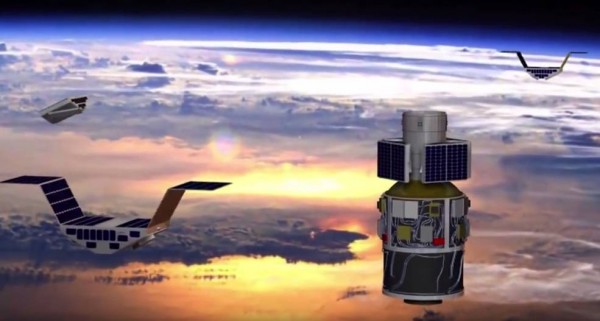By Ana Verayo, | November 15, 2016

The primary science goal of Cyclone Global Navigation Satellite System (CYGNSS) is to better understand how and why winds in hurricanes intensify. (NASA)
NASA is busy preparing for a new satellite mission that will track hurricanes. The swarm of satellites, which scientists call a "constellation" of hurricane tracking satellites, would be deployed in the event of an incoming hurricane.
Like Us on Facebook
This swarm of hurricane trackers known as the Cyclone Global Navigation Satellite System is slated to be launched this month from the Cape Canaveral Air Force Base in Florida.
The goal of this hurricane satellite mission is to develop new technology to obtain faster and more accurate predictions of a storm surge and track hurricane trajectories. From lower Earth orbit, this fleet of tiny satellites can monitor weather patterns and systems to prepare for the onslaught of a powerful hurricane and warn communities for evacuation.
NASA will launch eight microsatellites under this mission. The satellites possess wind speed tracking technology, and each satellite can obtain four wind measurements every second.
According to NASA's CYGNSS mission's principal investigator, Chris Ruf of the University of Michigan, there is still a lot to learn about the dynamics and processes of cyclones especially within the critical eyewall region of the storm, and this is where CYGNSS will obtain data from.
Scientists also consider the CYGNSS system as one of the most advanced hurricanes and cyclone tracking systems that utilize GPS technology. NASA scientists also plan to study and obtain data from heavy rainstorms for more accurate weather tracking and predictions.
The most important part of the CYGNSS mission is tracking and analyzing what goes inside the eye of a hurricane to gain crucial data and new insight about how storms become powerful and intense.
We cannot see the storm and everything that is occurring under the rain, and with CYGNSS, we can now measure the winds outside the storm cell with present systems, Ruf said.
-
Use of Coronavirus Pandemic Drones Raises Privacy Concerns: Drones Spread Fear, Local Officials Say

-
Coronavirus Hampers The Delivery Of Lockheed Martin F-35 Stealth Fighters For 2020

-
Instagram Speeds Up Plans to Add Account Memorialization Feature Due to COVID-19 Deaths

-
NASA: Perseverance Plans to Bring 'Mars Rock' to Earth in 2031

-
600 Dead And 3,000 In The Hospital as Iranians Believed Drinking High-Concentrations of Alcohol Can Cure The Coronavirus

-
600 Dead And 3,000 In The Hospital as Iranians Believed Drinking High-Concentrations of Alcohol Can Cure The Coronavirus

-
COVID-19: Doctors, Nurses Use Virtual Reality to Learn New Skills in Treating Coronavirus Patients







